AWS Cloud Adoption Framework
Overview
The AWS Cloud Adoption Framework (AWS CAF) makes creative use of AWS. It draws on AWS expertise and best practices to assist you in digitally transforming and accelerating your business outcomes. Utilize the AWS CAF to analyze and enhance your cloud readiness, identify and prioritize transformation opportunities, and iteratively develop your transformation strategy.
What is AWS Cloud Adoption Framework?
Your web services are instantly accessible through Amazon Web Services (AWS) from any global location with an internet connection. Companies may quickly deploy applications by utilizing this highly scalable platform. The developed solutions can also be centrally updated, deactivated, and temporarily or permanently reconfigured to reduce costs for the business. In this scenario, you will never pay more than you use in terms of resources.
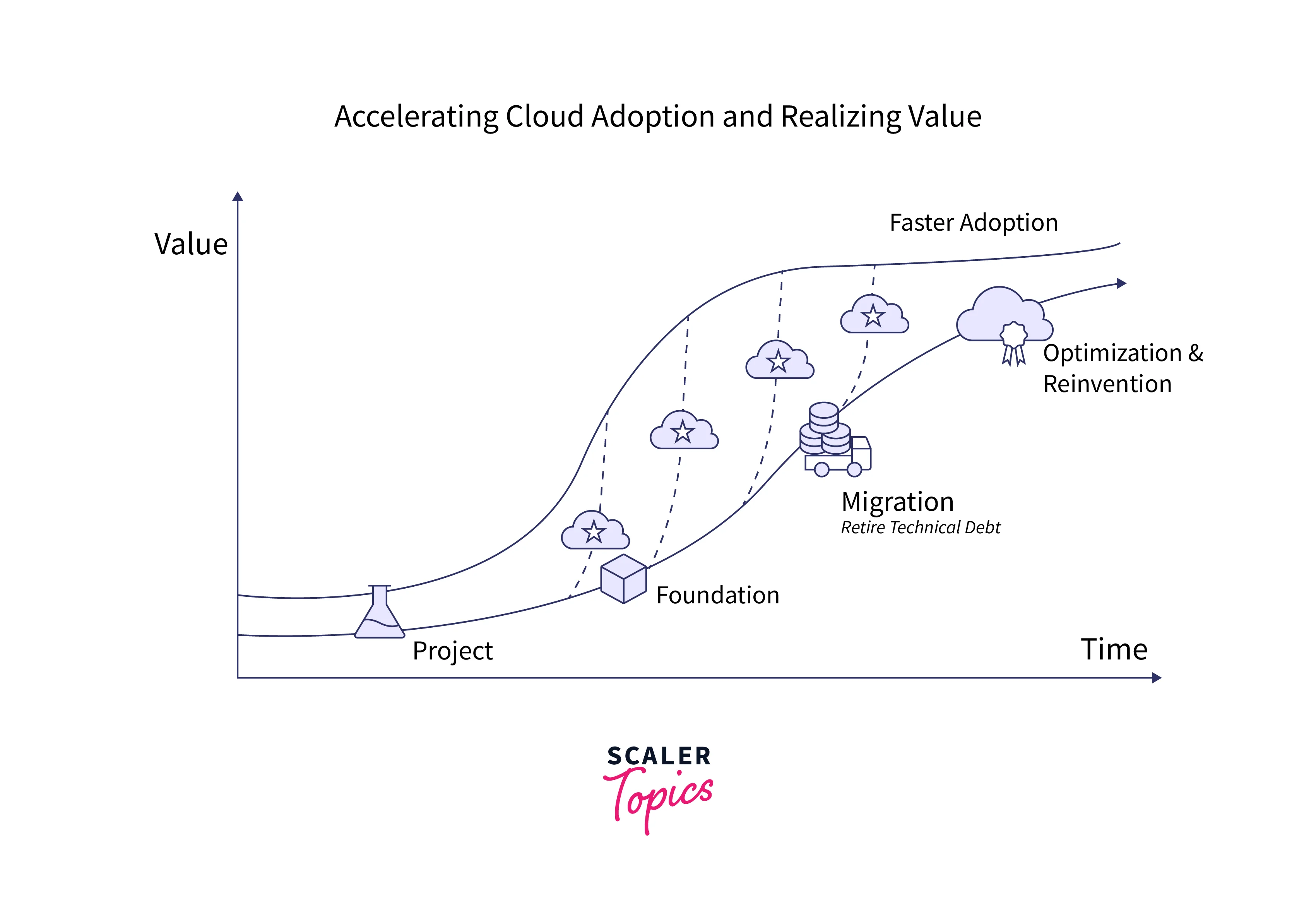
A complete collection of suggestions for installing, modifying, customizing, and maintaining workflows connected to already deployed software is offered by the AWS Cloud Adoption Framework (AWS CAF). Thousands of businesses currently utilize AWS CAF, and more intend to do so shortly as they move to the cloud. Organizations may create a roadmap for cloud migration with the aid of the AWS Cloud Adoption Framework (AWS CAF), swiftly fill knowledge gaps in their IT departments, and deploy applications in various settings.
Accelerating the Value of a Business Using Cloud Transformation
The following diagram illustrates how the cloud-powered organizational change (transformation) made possible by a set of fundamental capabilities speeds up business outcomes. The transformation domains depict a value chain in which technological change enables process change, allowing organizational change, which permits product change. The essential business benefits are reduced company risk, enhanced environmental, social, and governance (ESG) performance, and more significant revenue and operational efficiency.
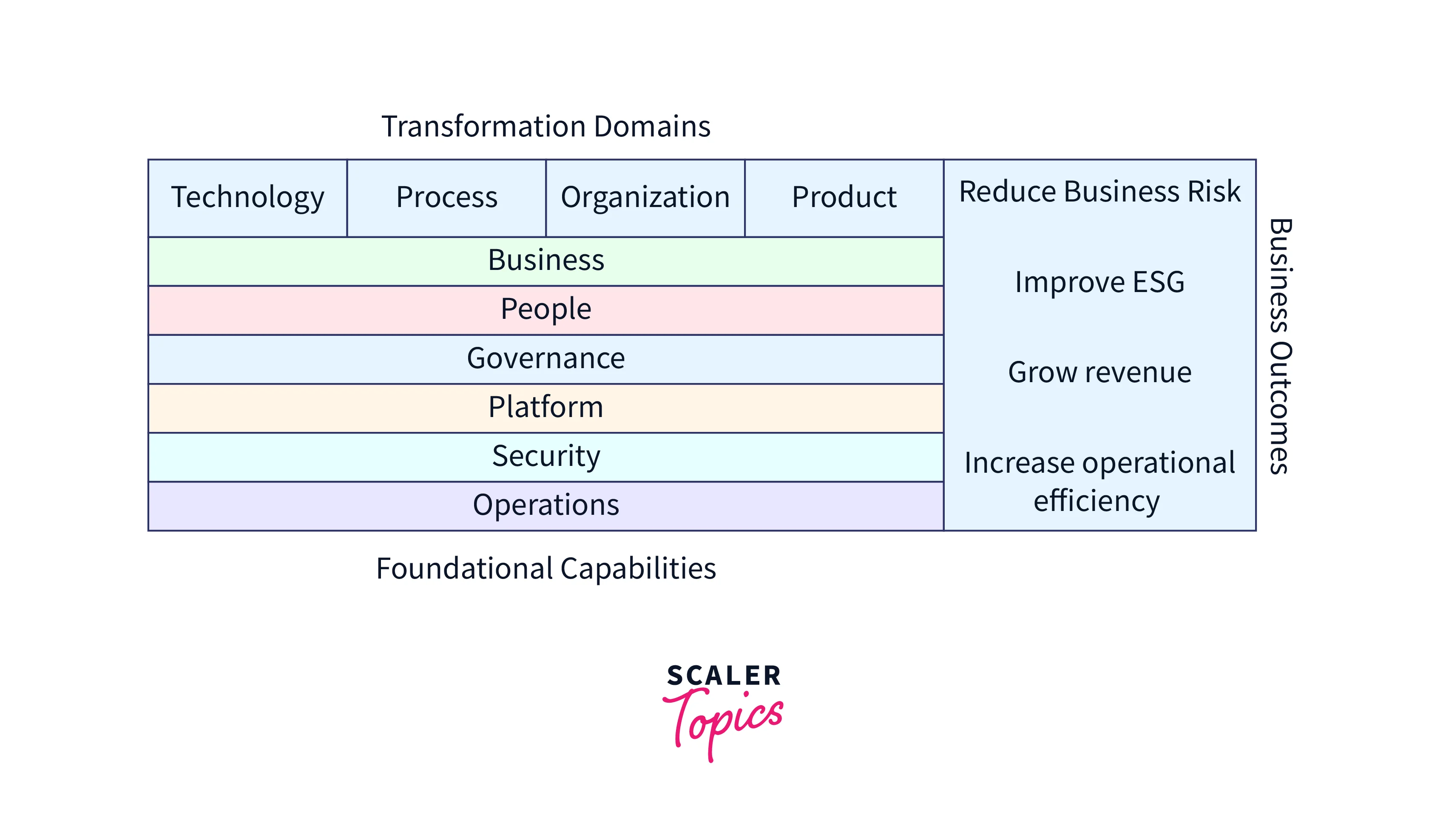
Value Chain for Cloud Transformation
- The main goal of technological transformation is to move and update outdated infrastructure, software, and data and analytics platforms. According to Cloud Value Benchmarking, switching from on-premises to AWS results in a 27% decrease in cost per user, a 58% rise in the number of virtual machines managed per administrator, a 57% drop in downtime, and a 34% drop in security events.
- The goal of process transformation is to digitize, automate, and optimize your company's activities. This could involve utilizing cutting-edge data and analytics platforms to generate actionable insights or machine learning (ML) to enhance staff productivity, company forecasting, fraud detection, industrial processes, and other areas.
- Reimagining your operational model—how your business and technology teams coordinate their efforts to deliver value to customers and achieve your strategic objectives—is at the center of organizational transformation. You may increase responsiveness and focus on your customers by structuring your teams around products and value streams and using agile methods to iterate and adapt quickly.
- A key component of product transformation is reinventing your company model by developing new value propositions (i.e., goods and services) and financial structures. By doing this, you can tap into new markets and demographics of consumers. AWS adoption results in a 37% decrease in time-to-market for new features and apps and a 342% increase in the frequency of code deployment.
Cloud Transformation Journey
The journey to the cloud for each company is distinct. You must visualize your ideal target state, assess your level of cloud readiness, and use an agile methodology to close the gaps if you want your transition to be successful. You may demonstrate benefit by transforming progressively while reducing the need to make broad projections. Using an iterative strategy, you can retain momentum and refine your plan as you gain experience. Four gradual and iterative cloud transformation steps are suggested by the AWS CAF, as represented in the accompanying diagram.
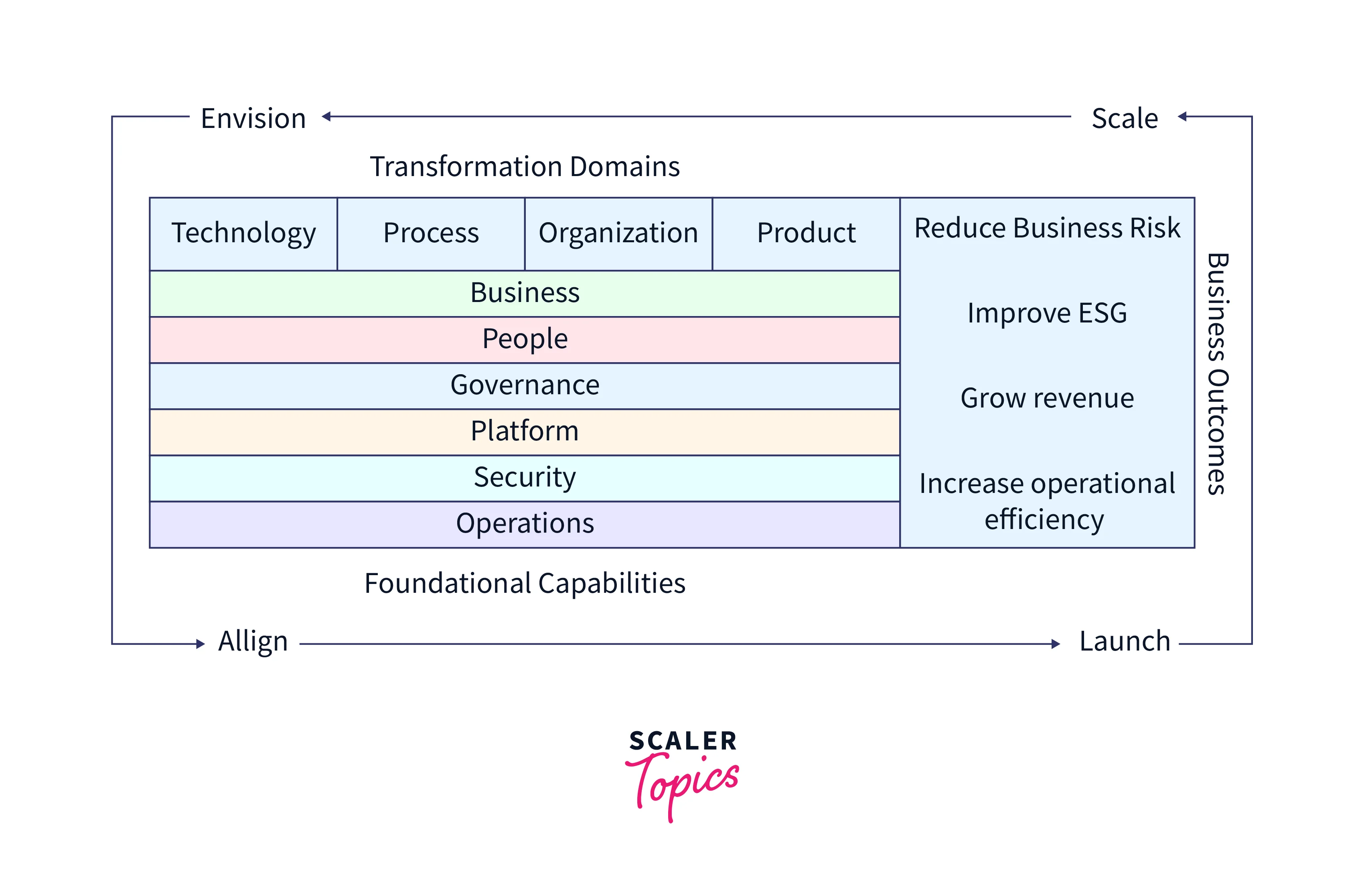
Journey of Cloud Transformation
-
Envision Phase: It focuses on illustrating how cloud computing may hasten commercial results. According to your strategic business objectives, it accomplishes this by locating and ranking transformation possibilities across each of the four transformation domains. As you advance along your transformation path, it will be easier to show value if you link your transformation projects with key stakeholders (senior figures capable of influencing and driving change) and measurable business outcomes.
-
Align Phase: It is concentrated on revealing stakeholder issues and difficulties, finding competency gaps across the six AWS CAF perspectives, and identifying cross-organizational dependencies. You may develop ways to increase your cloud readiness by doing this.
-
Launch Phase: Its primary goals are to deliver pilot projects in production and prove increased business value. Pilots should have a significant impact, and if/when successful, they will assist shape future courses. Before growing to total production, you can improve your strategy by taking lessons from pilots.
-
Scale Phase: It emphasizes scaling up production pilots and business value to the desired level and ensuring that your cloud investments' financial rewards are realized and maintained.
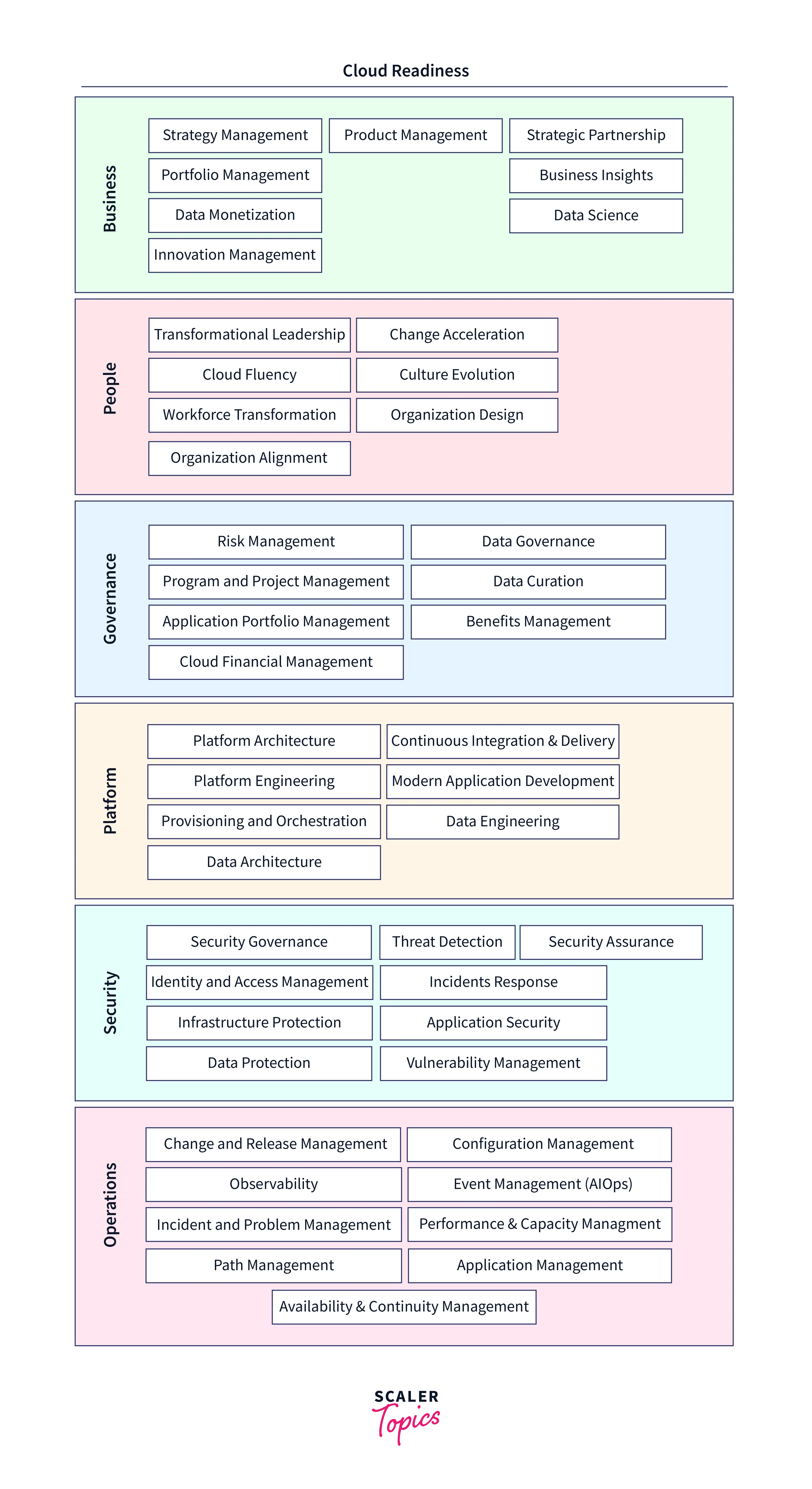
Benefits of AWS CAF
- Reduce Business Risk: You can reduce your risk profile with AWS CAF due to strong security, performance, and dependability.
- Improve Environmental, Social, and Governance Performance: With the aid of the AWS Cloud Adoption Framework, utilize insights to enhance sustainability and corporate transparency (AWS CAF).
- Increased Income: With AWS CAF, you may develop new goods and services, connect with new consumers, and explore new business niches.
- Availability and Scalability: AWS CAF ensures that your organization enjoys the industry-high 99.9% availability and scalability with AWS cloud up to the Application Login layer.
- Increase Operational Efficiency: Reduce operating expenses, boost output, and enhance employee and customer satisfaction.
- Dependency, Discovery, & Planning: Tasks, including technical assessments, hardware/software evaluations, and application dependency mapping, are carried out to increase the likelihood of smooth and seamless cloud migration. AWS CAF focuses on the infrastructure and data of your application's preparation for the cloud to ensure the best outcomes.
Working on AWS Cloud Adoption Framework
AWS Cloud Adoption Framework works in four different phases simultaneously which are explained below:
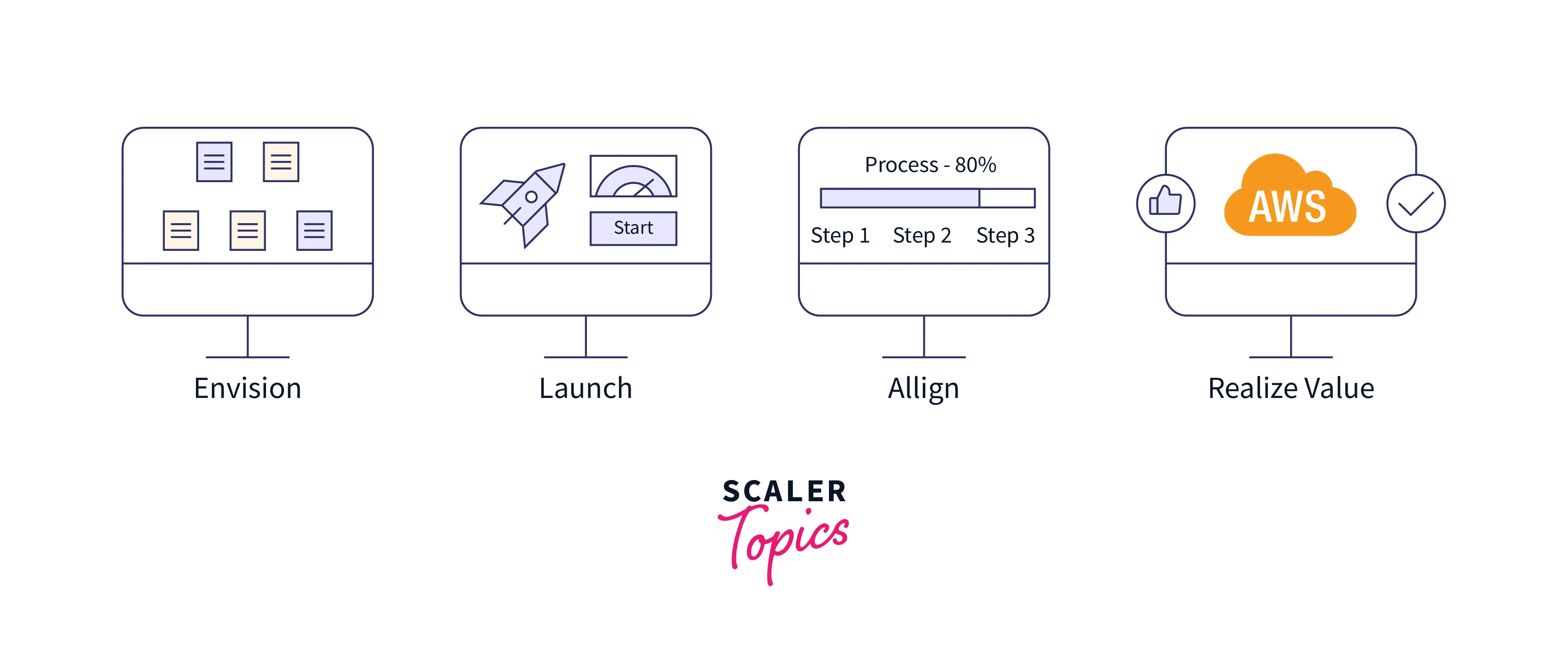
-
Envision: Having developed a solid plan for moving to the AWS cloud, you may implement it with the least effort and expense. Selecting the best technological stack can create long-term prospects for your company.
-
Align: In addition to carefully outlining the procedures for cloud migration, this stage entails creating a clear action plan to identify your company's specific advantages. This will enable you to determine all the risks connected with the relocation process and select the best strategy for its execution.
-
Launch: During this AWS CAF phase, you can develop the workflows necessary to deploy cloud services and raise the value of your business. Due to this, adding the latest web services to your existing network infrastructure is simple, and you may use them right away.
-
Realize Value: You will evaluate the effectiveness of innovations and plan an expansion of your company's strategy throughout this phase. You can regularly evaluate the results of the updated workflows with the anticipated plans and adjust your chosen approach as a result.
Use Cases of AWS CAF
- Technology: Utilize AWS CAF to migrate and modernize outdated infrastructure, apps, and data and analytics platforms. According to Cloud Value Benchmarking, switching from on-premises to AWS results in a 27% decrease in cost per user, a 58% rise in the number of virtual machines managed per administrator, a 57% drop in downtime, and a 34% drop in security events.
- Process: Digitize, automate, and improve your company's processes with the AWS Cloud Adoption Framework (CAF). This could involve utilizing cutting-edge data and analytics platforms to produce actionable insights or machine learning (ML) to enhance staff productivity and decision-making, company forecasting, fraud detection and prevention, industrial processes, and customer service.
- Organization: Consider new ways for your business and technology teams to accomplish your strategic goal and provide customer value. Increase your responsiveness and focus on your customers by structuring your teams around products and value streams and using agile methods to iterate and adapt quickly.
- Product: Create new value propositions and income models to reimagine your business strategy. According to Cloud Value Benchmarking, using AWS reduces time-to-market for new features and applications by 37%, increases the frequency of code deployments by 342%, and cuts the time it takes to deploy new code by 38%.
AWS CAF Capabilities and Prospects
Every AWS CAF Perspective has a set of obligations that individual employees of the company must meet. It is, in essence, the benchmark that establishes the security and economic viability of moving to the Amazon cloud.
Let's take a closer look at the key security features of the AWS Cloud Adoption Framework.
Business Perspective
Instead of making specific strategies to achieve specific business benefits, you may utilize the AWS Cloud Adoption Framework (AWS CAF) to establish a global business model with a long-term vision to expand and adapt to changing market demands. Managers and business owners will gain from this perspective in that they will:
- Give excellent planning opportunities,
- Improve end-user wants satisfaction,
- Optimise the distribution of funds, and
- Contro company risks from beginning to end, both external and strategic.
Governance Perspective
This perspective aids in the organization and coordination of non-IT business processes and software. IT managers, architects, and business analysts will find it useful because:
- Scheduling cloud workloads and correctly setting service priorities;
- Selecting the appropriate cloud migration techniques;
- Cost reduction;
- Licencing administration.
Operations Perspective
This AWS Cloud Adoption Framework perspective assists in managing workloads to the current and future needs of the business. You may, therefore, quickly create and carry out a new business strategy with little risk. During this stage, the following will be advantageous for operators in technical support:
- Service monitoring to determine the IT operations' level of efficiency and to ensure corporate standards are met when using cloud-based applications;
- Release/change management for a wise choice of continuous integration/continuous delivery (CI/CD) techniques, resource inventory management to rationalize the use of virtual IT assets;
- Reporting and analytics for tracking performance;
- Establishing backups and evaluating downtime for ongoing business operations.
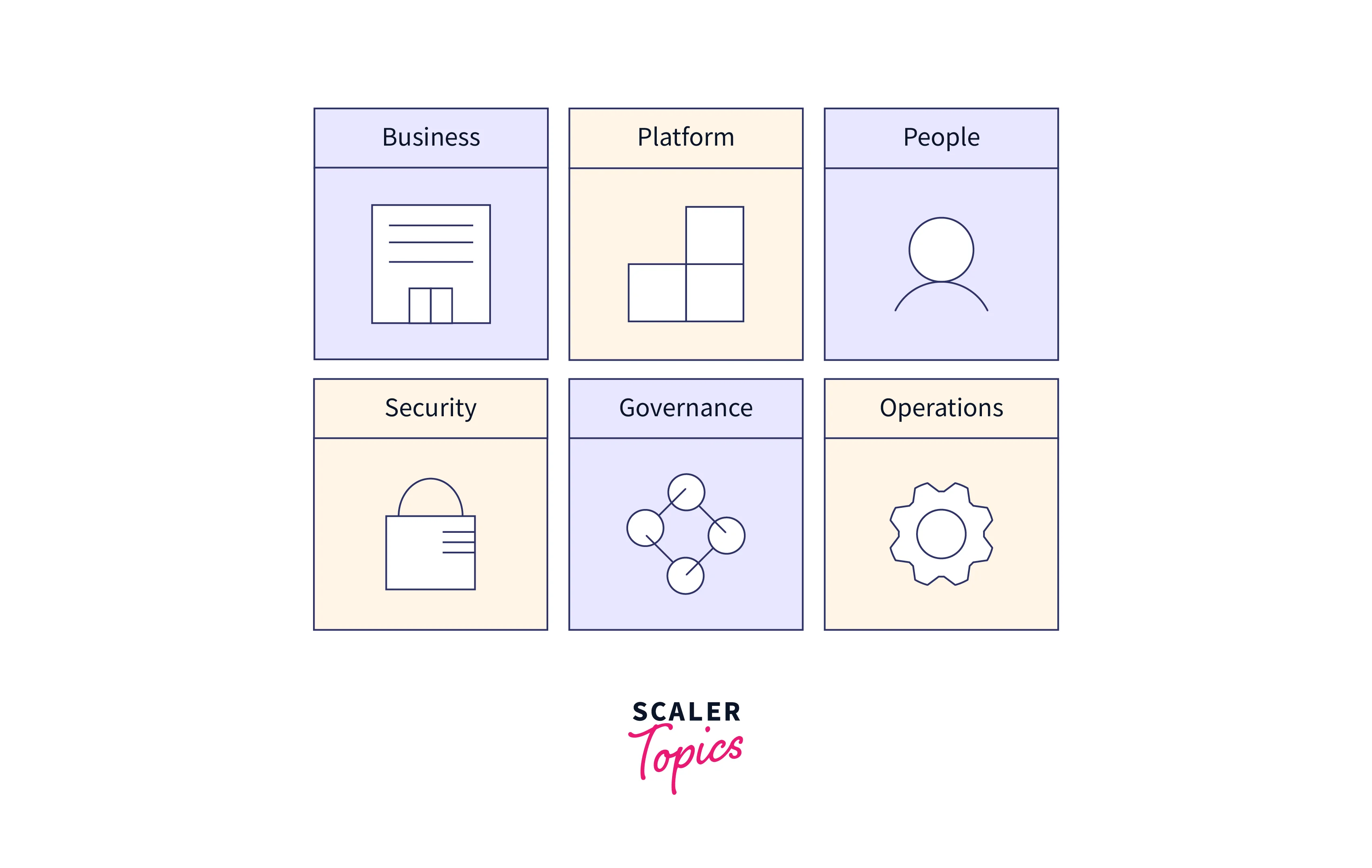
Security Perspective
This perspective of the AWS Cloud Adoption Framework aids in managing workloads by present and foreseeable business requirements. You may quickly create and carry out a new business strategy with little risk. These are the security advantages they receive from the AWS Cloud Adoption Framework:
- IAM (Identity and Access Management), which offers thorough instructions on incorporating AWS into user authentication and authorization operations;
- Detecting suspect network activity is the responsibility of detective control;
- Infrastructure security, which is in charge of creating rules and security specifications;
- Data protection, which aids in the development of effective methods for securing data during transport and storage operations;
- Service for an incident response that enables quick reaction to unusual network activity.
People Perspective
HR professionals can better prepare their staff for the move to the cloud by taking this into account. In particular, HR specialists receive:
- The improved network architecture's capacity to forecast new openings;
- Putting together a shared set of abilities for cloud migration;
- Creating a training program to prepare staff to perform their regular duties in a modern setting.
Platform Perspective
The platform perspective enhances the network infrastructure built using AWS. For network architects, CTOs, and managing IT team members, it is essential. These are the advantages they receive:
- Knowing the specifications that the system's design should adhere to;
- The outlook for potential growth and the development of new cloud-based workflows;
- Coordinating new business objectives with the increased processing power provided by the cloud.
Conclusion
- This article taught us about WS Cloud Adoption Framework or AWS CAF.
- During the migration of Amazon Web Services, AWS CAF offers security, scalability, and effectiveness.
- This article also explained various use cases of AWS CAF. It also explained how we could automate the deployment process with AWS CAF.
- We also learned about six perspectives of AWS CAF. It included Business Perspective, Governance Perspective, Operations Perspective, Security Perspective, People Perspective, and Platform Perspective.
- Ultimately, we learned how AWS CAF works. It involved four phases: Envision, Launch, Align, and Realize Value.
